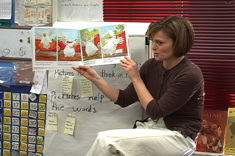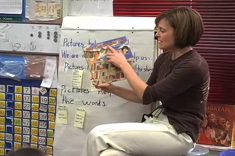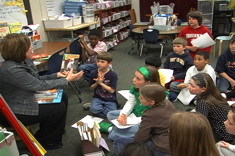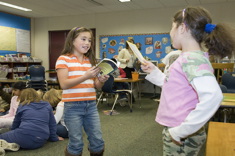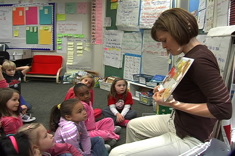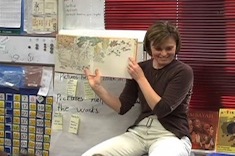During our series study, I read lots of picture books, and I am also reading many new early readers that have the feel of chapter books. In second grade, I struggled with when to start a "chapter book" read aloud – not so much because I thought the kids weren't ready for the comprehension work (I could scaffold when needed), but rather I was concerned that if I read a chapter book too early, most kids would want to just read chapter books. I was also concerned with finding the perfect book to read aloud. There are so many different interests, abilities, background knowledge, and levels of stamina within a group of 22 students. A friend suggested Toys Go Out by Emily Jenkins and I was sold after reading the first page. This imaginative story about the adventures of a Lumphy (a stuffed buffalo), Plastic (a ball) and a plush toy named Stingray won the hearts of my students.
After sharing Toys Go Out during read aloud, I was anxious to assess what was going on in kids' minds as they listened to the story. I asked them to draw a picture of their favorite character (knowing most of them had not listened to a story with three main characters). Their illustrations gave me a glimpse into what they were enjoying and remembering about the first few pages.
One student drew a detailed backpack that held the three friends (Lumphy, Plastic and Stingray). Her picture revealed she understood there were three characters and where the characters were (setting). Another day after read aloud, I asked the children to write what they were thinking (anything!) after listening to the story. We sorted their thoughts into categories I labeled as kids read a few of their thoughts aloud.
We made connections, many inferences about characters, and some questions about what was happening or might happen next in the story. After all this discussion of thinking, I decided to begin an anchor chart where I gradually added character names, character traits and class thoughts about the story after listening to Toys Go Out each day. I observed a few things based upon our chart:
- Kids were drawn to noticing and making observations about character. This practice of noticing and naming character traits helped build new vocabulary and comprehension for words like: peaceful, curious, brave, embarrassed, explores and wanders.
- Some students were drawn to figuring out theme within and at the end of the chapters. After one student decided the first chapter was about being thankful for what you have, it created a challenge for everyone to share what the big idea was at the end of a chapter.
- After observing so much discussion on theme of the chapters and character traits, I would often ask kids to think back and explain why they had that thought or where there was evidence for it in the story.
-
I knew the kids were ready to begin exploring the notion of supporting their thoughts. I decided to introduce this through questioning study with the early reader series Upstairs Mouse, Downstairs Mole
.
Moving Forward with Upstairs Mouse, Downstairs Mole
I used the first Mouse and Mole in the series of five books to model how to generate questions after a preview. After introducing the series Upstairs Mouse, Downstairs Mole, I asked students to generate questions they were thinking about the book. Questions included:
What is a mole?
Why is the mole blue?
What's an oar?
Why are they next-door neighbors?
Do mice live in trees?
How far away do they live?
Why are they friends?
We reread the questions (without answering them, which was hard for some students) to decide which question would help us understand the whole book.
The children selected Why are they friends? as the central question for the book. We used this question as I begin reading aloud the different stories in the different chapters of the book. I wrote the question on a separate anchor chart so that we could remember it as we listened.
After the short story chapters, students turned and talked about how they might answer that question for the particular chapter. I then used post-its to record kid thinking about the question.
For example, in Chapter 1: Clean and Tidy, the responses I received included:
1. They help one another make their houses tidy and clean.
2. They figure out stuff together.
I then asked the students to talk with their partner about times in the story that these incidents occurred. The kids used examples like mouse and mole sat on the stump and shared ideas or they have things in common: they live in the same tree and they both like to clean. After this conversation and their examples, we decided that all these things show that mouse an d mole care about each other. The other short stories also involve mole and mouse working through issues that new friendships undergo, like hurting each other's feeling for the first time. This book gave students opportunities to think through character traits in an age-appropriate way. Because this is one of five books in the series, I hope that they will yearn to read more of the adventures in the other books.
Using Baby Brains in Series Study
in Series Study
The series Baby Brains by Simon James was a favorite in my room, and I had recently discovered the third book in the series, Baby Brains Superstar
. Knowing the kids had not heard this story yet and loved the character already, it was perfect for beginning to practice comprehension strategies. I previewed the book by reading the title, commenting on the pictures, and reading aloud the inside flap of the cover. I asked students to chime in with questions during the preview.
We jotted the questions on an anchor chart in green, and then came back and filled in our observations. Students brainstormed questions that helped them think deeper about Baby Brains (i.e., Why is he so smart? What else does he need? Why does he want to play music? Why is Baby Brains in the mom's stomach at the beginning of all the stories?). They knew the character from the first two books in the series, but it wasn't until we questioned and tried to answer our questions that we began to understand him further.
The series study helped me tackle many goals. Students developed an awareness of the characteristics of series books as they explored them with partners. They benefited from sorting books and learning features of series books that would help them begin to choose appropriate books independently. They experienced rich thinking and conversation about series stories and characters. With this study, my hope is that they will continue to share series they love with each other, anticipating the next books in favorite series.
A collection of series books for possible study (including picture books and early chapter books):
Elephant and Piggie Books by Mo Willems
Good Luck Bear, Thank You Bear
, Don't Worry Bear
by Greg Foley
Dog and Bear: Two Friends Three Stories, Dog and Bear: Two's Company
by Laura Vacarro Seeger
What Will Fat Cat Sit On?, A Birthday for Cow!
, The Doghouse
by Jan Thomas
Fancy Nancy, Fancy Nancy and the Posh Puppy
, Fancy Nancy: Bonjour, Butterfly
by Jane O'Connor
Sergio Makes a Splash, Sergio Saves the Game
by Edel Rodriguez
Baby Brains by Simon James
Upstairs Mouse, Downstairs Mole by Wong Herbert Yee
Meet Mr. and Mrs. Green by Keith Baker
Cowgirl Kate and Cocoa by Erica Silverman and Betsy Lewin
Henry and Mudge by Cynthia Rylant
Annie and Snowball by Cynthia Rylant
Mr. Putter & Tabby by Cynthia Rylant
Fly Guy by Tedd Arnold
Fox Books by James Marshall
Frog and Toad by Arnold Lobel
Iris and Walter by Elissa Haden Guest
Mercy Watson by Kate DiCamillo

